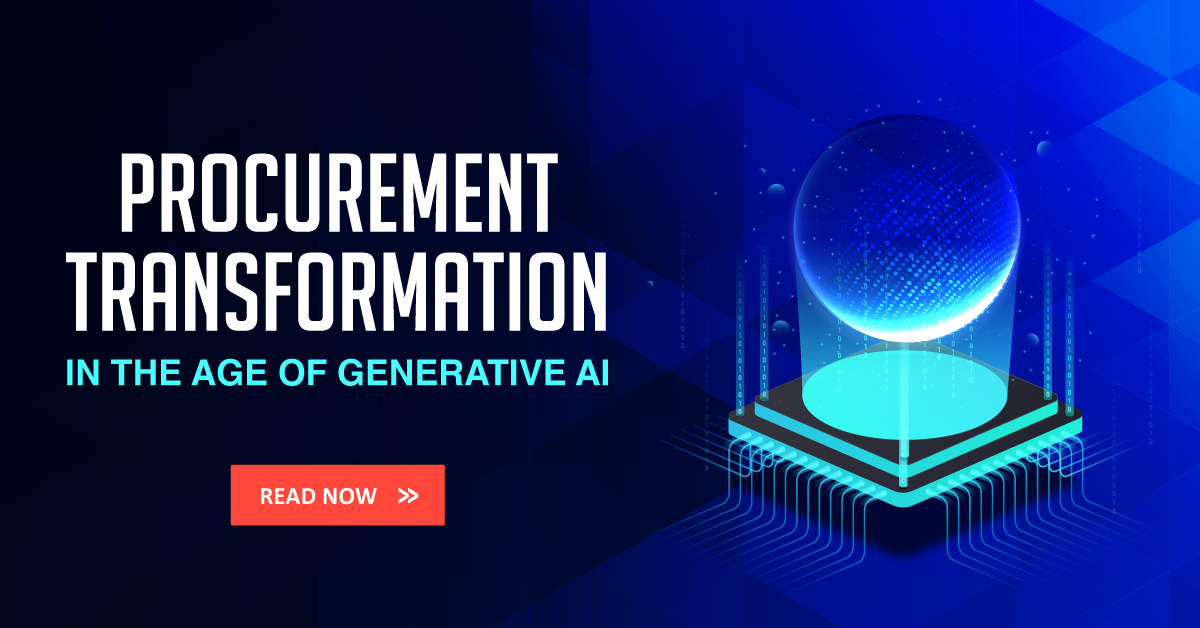
Top 3 Use Cases of Generative AI in Procurement
- Generative AI is set to transform procurement processes and accelerate digital transformation.
- The current state of technology adoption shows that, unlike other business functions, procurement hasn’t actively adopted advanced technology solutions.
- Document creation and decision-making support are among the several use cases of Generative AI in procurement.
January 15, 2024 | Procurement Software 4 minutes read
Ever since the launch of ChatGPT, the rapidly evolving branch of artificial intelligence, known as Generative AI, has seen tremendous interest across several industries.
What makes Generative AI better than previous AI-based solutions is its ability to create new data that is similar to, but not a copy of, the training data, enabling it to self-learn continuously. This means that it can generate creative outputs beyond predefined tasks, domains and existing patterns. This also brings its creative, problem-solving and content-generation skills very close to those of a human.
Like many other business functions, procurement organizations know there is a huge opportunity to accelerate digital transformation and reform several processes with this technology.
Why is this important for procurement?
Because in many enterprises, procurement is quickly evolving from a back-office function to a critical business unit that is now entrusted with strategic responsibilities. The function’s scope of work has expanded beyond traditional cost savings to managing risks, establishing strategic supplier relationships and ensuring business continuity.
Additionally, procurement has to play a key role in driving ESG and sustainability initiatives.
How can procurement take on the additional responsibilities and meet the desired expectations?
By deploying advanced AI-powered technology, procurement can add more value, do more with less and accomplish tasks that were earlier performed by core business units.
Current State of Technology Adoption in Procurement
Compared to other business functions such as human resources (HR) and finance and accounting (F&A), procurement teams have not actively adopted advanced technology solutions. The little digitalization efforts in procurement have focused primarily on leveraging basic analytics, robotic process automation (RPA) and rule-based chatbots, says a recent report by the Everest Group and GEP.
Mature procurement organizations have adopted advanced technologies on a limited basis. While some teams have adopted intelligent document processing (IDP) to automatically extract unstructured data from documents, a few others leverage AI-powered intelligent automation solutions to automate complex workflows and processes.
The overall adoption of AI-/ML-based cognitive solutions in procurement is limited yet growing at a steady pace, the report adds.
Also Read: The Impact of ChatGPT on Supply Chain Efficiency and Agility
Where Can AI-Based Solutions Make a High Impact
Procurement leaders are keenly tracking developments in the Generative AI space to identify potential high-impact use cases across the source-to-pay (S2P) value chain. Processes that require creative content generation and innovative problem-solving capabilities are best suited for deploying this technology.

According to the report, the use cases of generative AI across the S2P value chain can be broadly classified into 3 categories:
1. Document creation:
Generative AI can automate the creation of key documents including requisitions, purchase orders, invoices, RFXs and contracts. With appropriate prompts, it can create the desired type, format and template of these documents almost immediately. This reduces the time and effort required to manually create these documents for different categories, suppliers and locations.
2. Decision support:
Advanced data processing and analytics capabilities as well as a human-like conversational style make Generative AI immensely useful for decision-making in procurement. For example, procurement can use the technology to identify suitable suppliers based on multiple parameters such as location, historical performance, financial health, service capability, pricing and language support.
Likewise, Generative AI can drive supplier negotiations on behalf of procurement. It can compute real-time pricing benchmarks and derive insights from market intelligence and historically recorded transactions to develop better negotiation strategies. Generative AI can simplify supplier relationship management by running periodic performance evaluations through customized scorecards. It can also detect and flag anomalies in the information submitted and monitor supplier risks on an ongoing basis.
Additionally, Generative AI can help formulate strategies based on business priorities. For example, it can help procurement identify cost-saving opportunities based on its understanding of the supplier landscape, regional nuances, category intelligence and organization-specific requirements.
3. Virtual assistance:
Procurement can leverage Generative AI as a virtual buying assistant and transform guided buying. It can also deploy technology to automatically generate responses to common procurement-related queries from suppliers as well as internal stakeholders. This can reduce the workload, improve response time and ensure accuracy in the information provided.
In addition to the above use cases, procurement teams are likely to discover many new applications of Generative AI in their daily operations as the technology continues to evolve. While they can automate several routine tasks and focus on value-adding tasks, they can also have a human-like conversation with the platform and get answers almost immediately to many of their everyday queries.
Download the full report Procurement Transformation in the Age of Generative AI




